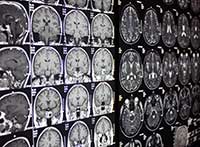 Gamma knife is a computer-guided therapy approach that is performed in a single session. The “blades” of a gamma knife are actually made up of gamma radiation that is programmed to target a problem area. There are about 200 small beams of radiation—and while each beam has little effect on the tissue is passes through in order to reach its destination, the radiation delivers precise therapy at the location where all beams meet together. A lightweight frame may be attached to the head with pins in order to keep the head stabilized and act as a point of reference for the beams.
Gamma knife is a computer-guided therapy approach that is performed in a single session. The “blades” of a gamma knife are actually made up of gamma radiation that is programmed to target a problem area. There are about 200 small beams of radiation—and while each beam has little effect on the tissue is passes through in order to reach its destination, the radiation delivers precise therapy at the location where all beams meet together. A lightweight frame may be attached to the head with pins in order to keep the head stabilized and act as a point of reference for the beams.
Gamma knife radiosurgery is a non-invasive option for patients who cannot handle traditional brain surgery. It requires no incision to expose the inside of the brain, therefore reducing the amount of complications. Gamma knife radiosurgery can even be performed on an outpatient basis.
Gamma knife radiosurgery may be utilized for cases such as:

- Brain tumors – Intracranial tumors (usually 5cm or smaller) can have genetic material damaged by the gamma knife, resulting in the cells being unable to reproduce any longer
- Arteriorvenous malformations – Gamma knife radiosurgery can destroy brain vascular lesions
- Trigeminal neuralgia – With this and other functional problems, gamma knife radiosurgery can create a lesion to block pain signals
Gamma knife radiosurgery is virtually painless, and the patient will not feel radiation. There are slight risks involved with the procedure, such as headaches, nausea, swelling, fatigue, tenderness, and visual changes.




